Clean, safe water is essential for every household, but many homeowners are unaware of the significant impact their water quality has on the type of filtration system they use. Whole-house water filters provide a convenient solution by treating water at the point of entry, ensuring that every faucet and appliance receives filtered water.
The effectiveness of these systems largely depends on the cartridge inside—each type is designed to target specific contaminants and improve water quality in different ways. While the average person may not think about what goes into their filter, understanding the various types of cartridges can help you make an informed decision for your home.
Let’s explore the most common types of whole-house water filter cartridges, their working mechanisms, and which contaminants they effectively remove.
Table of Contents
ToggleUnderstanding Whole House Water Filters: Benefits and Functionality
Whole-house water filters are a crucial solution for ensuring clean and safe water throughout your entire home. Unlike point-of-use filters, which treat water at a single tap, these systems filter all the water entering your home, providing consistent quality for drinking, bathing, and household tasks. This guide explores what whole-house water filters are, their benefits, and how they function to improve water quality.
What is a Whole House Water Filter?
A whole-house water filter, also known as a point-of-entry system, is installed at the main water line to treat all water entering your home. These systems are designed to remove a wide range of contaminants, such as sediment, chlorine, and heavy metals, depending on the type of filter media used. Whole-house filters ensure that every faucet, shower, and appliance in your home receives filtered water, providing a comprehensive solution for water quality concerns.
Benefits of Using a Whole House Water Filter
Whole house water filters provide numerous advantages, including:
- Improved Water Quality: They remove impurities like sediment, chlorine, and harmful chemicals, ensuring cleaner water for all uses.
- Healthier Living: By reducing contaminants, these systems protect your family from potential health risks associated with poor water quality.
- Appliance Protection: Filtered water prevents scale buildup and corrosion, extending the lifespan of appliances like water heaters and washing machines.
- Convenience: Unlike point-of-use filters, a whole house system eliminates the need for multiple filters throughout your home.
- Enhanced Bathing Experience: Removing chlorine and other chemicals improves skin and hair health, making showers more refreshing.
How Whole House Water Filters Work
Whole house water filters operate in stages to address different types of contaminants:
- Pre-Filtration: The first stage removes large particles, such as sand, silt, and rust, thereby protecting the system and enhancing water clarity.
- Activated Carbon Filtration: This stage removes chlorine, odors, and organic compounds, thereby enhancing the taste and smell.
- Specialized Media: Depending on the system, additional stages may target specific contaminants, such as heavy metals, bacteria, or hard water minerals.
- Post-Filtration: Some systems include a final stage to polish the water, ensuring optimal quality before it reaches your taps.
By understanding the functionality and benefits of whole house water filters, you can make an informed decision to improve your home’s water quality and enjoy the convenience of filtered water throughout your household.
Types of Filter Cartridges: A Comprehensive Guide
Filter cartridges are essential components of water filtration systems, designed to address specific water quality concerns. Each type of cartridge serves a unique purpose, targeting different contaminants to ensure cleaner and safer water. This guide provides an overview of the most common filter cartridge types, including sediment and carbon filters, to help you understand their functionality and applications.
1. Sediment Filter Cartridges
Sediment Filter Cartridges are designed to remove larger particles like dirt, sand, silt, and rust, protecting downstream systems and appliances from clogging and damage. They come in various micron ratings (e.g., 1, 5, 10 microns) to capture different particle sizes. Common types include pleated, spun/depth, and string-wound filters, made from durable materials like polypropylene or polyester.
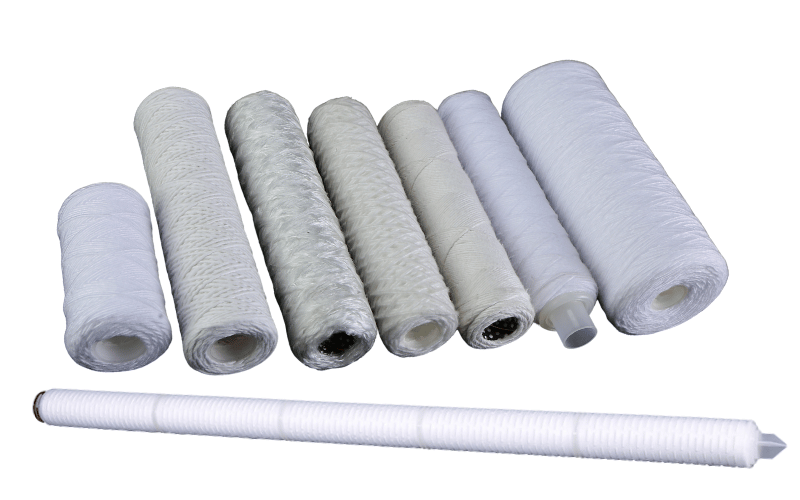
Key Benefits:
- Extend the lifespan of appliances and filtration systems.
- Cost-effective and easy to maintain.
- Ideal for residential, industrial, and pre-filtration applications.
Limitations:
- They don’t remove dissolved contaminants, such as chemicals or bacteria.
2. Activated Carbon Cartridges
What They Do:
Activated carbon cartridges are highly effective at reducing chlorine, volatile organic compounds (VOCs), and unpleasant odors in water. They improve the taste and smell of water, making it more pleasant for consumption.
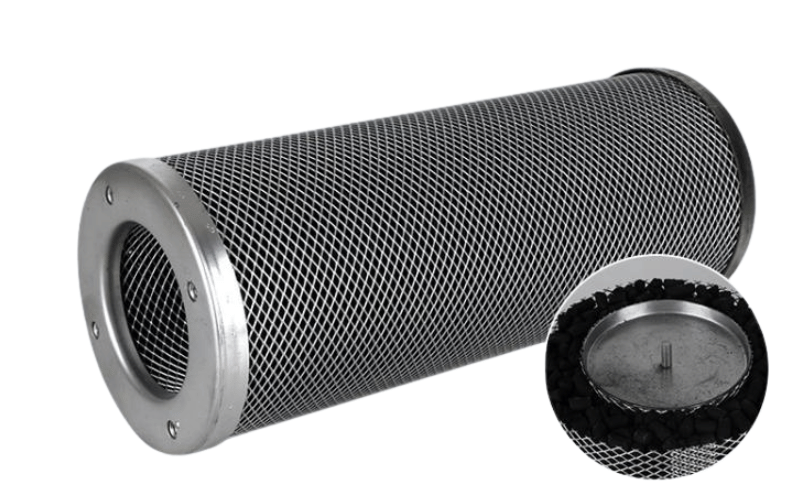
How They Work:
- Activated carbon has a porous structure that traps and absorbs contaminants through a process called adsorption.
- It targets chemicals and impurities that affect water quality but does not remove sediments or dissolved minerals.
Common Uses:
- Often used as the second stage in multi-stage filtration systems, following a sediment filter.
- Ideal for residential drinking water systems, commercial applications, and pre-treatment for reverse osmosis systems.
Benefits:
- Enhances water taste and odor.
- Reduces harmful chemicals like chlorine and VOCs.
- Protects downstream filters and systems from chemical damage.
Limitations:
- Does not remove sediments, heavy metals, or microorganisms.
- Requires regular replacement to maintain effectiveness.
3. Carbon Block Filters
Carbon Block Filters are a dense form of activated carbon that provides precise filtration by removing smaller particles, contaminants such as chlorine, VOCs, and heavy metals (e.g., lead), while also improving the taste and safety of the water. Their compact structure increases contact time, leading to better adsorption.
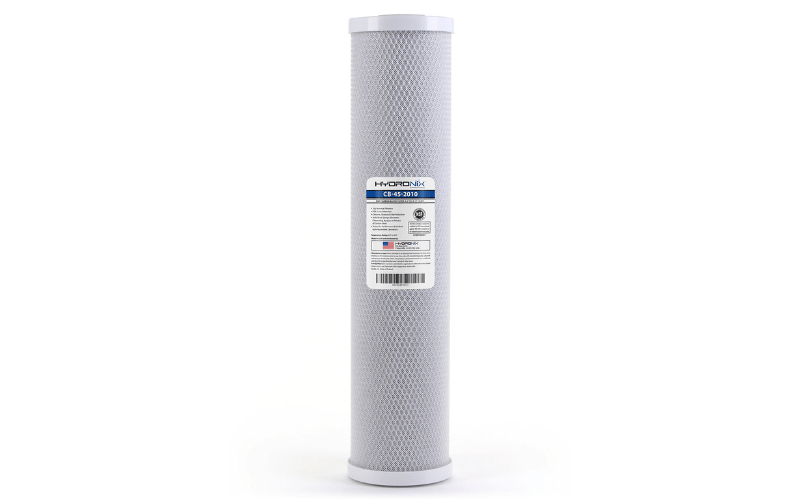
Key Benefits:
- Removes fine particles (down to 0.5 microns).
- Enhances water quality and taste.
- Ideal for residential and commercial filtration systems.
Limitations:
- Slower flow rate due to density.
- Requires regular replacement (6-12 months).
4. Iron and Manganese Filters
Iron and Manganese Filters are specialized systems designed to eliminate iron and manganese from water, which are common culprits behind reddish-brown stains on plumbing, laundry, and appliances, as well as unpleasant metallic tastes. These filters are particularly beneficial in areas reliant on well water, where these minerals are often present in higher concentrations.
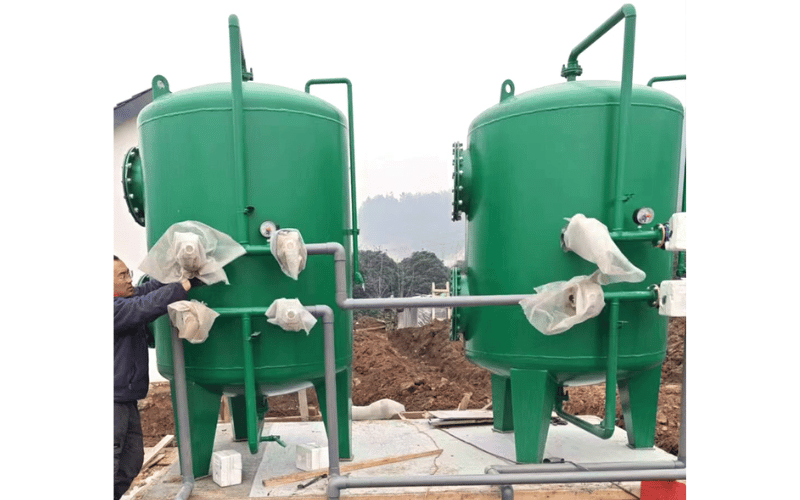
Key Benefits:
- Protects plumbing, laundry, and appliances from unsightly stains.
- Enhances the taste of water and eliminates metallic flavors.
- Some models also address hydrogen sulfide, reducing the “rotten egg” odor.
How They Work:
These systems utilize advanced filtration media, such as greensand or Birm, or employ oxidizing agents to capture and remove iron and manganese particles effectively.
Limitations:
- Specifically targets iron, manganese, and occasionally hydrogen sulfide.
- Requires regular upkeep, including backwashing and periodic media replacement, to maintain performance.
5. KDF (Kinetic Degradation Fluxion) Filters
KDF Filters utilize a unique copper-zinc alloy to effectively remove heavy metals like lead and mercury, reduce chlorine levels, and inhibit the growth of bacteria and algae. Their versatility and eco-friendly design make them a popular choice for various water filtration applications.

Key Benefits:
- Effectively removes heavy metals and chlorine, improving water safety and quality.
- Prevents the growth of bacteria, algae, and other microorganisms.
- Highly durable, environmentally friendly, and built to last.
Applications:
KDF Filters are commonly found in shower filters, whole-house filtration systems, and as pre-filters for carbon or reverse osmosis systems, enhancing the overall filtration process.
Limitations:
- Best used in combination with other filtration systems for comprehensive water purification.
6. Reverse Osmosis (RO) Cartridges
Reverse Osmosis (RO) Cartridges are advanced filtration systems that utilize a semi-permeable membrane to remove dissolved solids, including sodium, heavy metals, and nitrates, as well as other impurities. Often paired with pre-filters, they provide a thorough and reliable water purification solution.

Key Benefits:
- Removes up to 99% of contaminants, including harmful bacteria, viruses, and dissolved solids.
- Significantly enhances water taste and eliminates unpleasant odors.
- Suitable for a wide range of applications, including residential, commercial, and specialized uses like aquariums or laboratories.
Limitations:
- Generates wastewater as a byproduct of the filtration process.
- Operates at a slower rate and comes with higher costs compared to simpler filtration systems.
7. UV Sterilization Filters
UV Sterilization Filters harness the power of ultraviolet light to destroy bacteria, viruses, and other harmful microorganisms, providing microbiologically safe water without the use of chemicals. This method ensures clean, safe water while preserving its natural taste and quality.

Key Benefits:
- Eliminates up to 99.99% of harmful pathogens, including bacteria and viruses.
- Eco-friendly solution that adds no chemicals, taste, or odor to the water.
- Especially beneficial for homes relying on well water or those with concerns about contamination.
Limitations:
- Does not address chemical contaminants or sediment; pre-filtration is necessary for cloudy water.
- Requires a consistent power source to operate effectively.
8. Specialty Filters
Specialty Filters are tailored to address specific contaminants such as fluoride, nitrates, or hydrogen sulfide. These filters are often used in conjunction with other filtration systems to provide a more comprehensive water treatment solution.
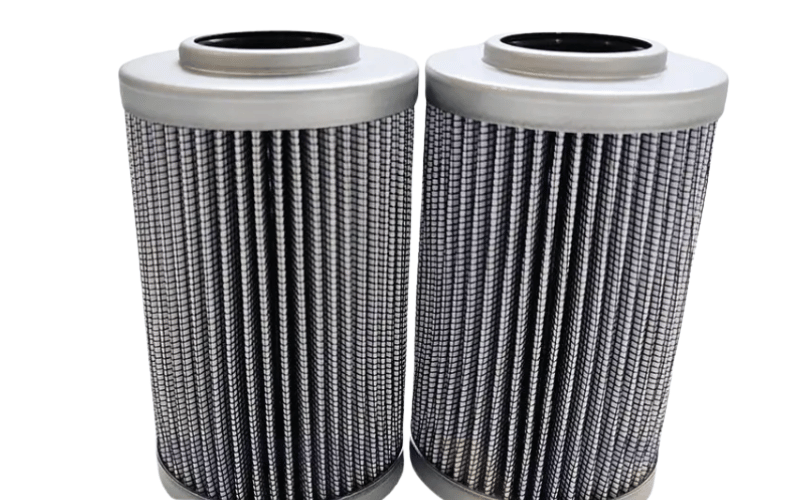
Key Benefits:
- Precisely targets and removes specific impurities for enhanced water quality.
- Improves the taste, odor, and overall safety of water.
- Customizable to tackle unique water quality challenges based on individual needs.
Limitations:
- Designed for single-purpose use, often requiring integration with other filters for complete purification.
- Higher cost due to the use of specialized filtration media.
These filter cartridges can be combined in multi-stage systems to address a wide range of water quality concerns, ensuring clean and safe water throughout your home.
Choosing the Right Cartridge Filter: Key Considerations and Maintenance
Selecting the right cartridge filter is essential for ensuring optimal water quality and system performance. With various options available, understanding the factors that influence your choice, the contaminants you need to address, and the importance of timely replacements can help you make an informed decision. This guide provides a detailed overview to help you choose and maintain the ideal filter cartridge for your specific needs.
Factors to Consider When Selecting a Filter Cartridge
When choosing a filter cartridge, it’s essential to evaluate your specific water filtration requirements:
- Water Quality: Conduct a water test to identify contaminants such as sediment, chlorine, or heavy metals.
- Filter Type: Select a cartridge designed to address your primary concerns, such as sediment filters for debris or carbon filters for chemical impurities.
- Micron Rating: Consider the filter’s micron rating, which determines the size of particles it can remove. Lower ratings capture finer particles.
- Flow Rate: Ensure the cartridge supports the required flow rate for your water system to avoid pressure drops.
- System Compatibility: Verify that the cartridge fits your existing filtration system and meets its specifications.
Common Contaminants and the Appropriate Filters
Different contaminants require specific types of filter cartridges for effective removal:
- Sediment: Use sediment filter cartridges to remove sand, silt, and rust, improving water clarity and protecting downstream equipment.
- Chlorine and VOCs: Carbon filter cartridges are ideal for reducing chlorine, odors, and volatile organic compounds, enhancing water taste and safety.
- Heavy Metals: Specialty filters, such as reverse osmosis or ion exchange cartridges, are effective for removing lead, mercury, and other metals.
- Bacteria and Viruses: For microbiological contaminants, consider filters with ultrafiltration or UV sterilization capabilities.
Replacement Frequency for Filter Cartridges
Regular replacement of filter cartridges is crucial for maintaining filtration efficiency and water quality:
- Manufacturer Guidelines: Follow the recommended replacement schedule, typically every 3 to 12 months, depending on the cartridge type and usage.
- Water Quality and Usage: High levels of contaminants or heavy water usage may require more frequent replacements.
- Performance Monitoring: Watch for signs of reduced flow rate, unpleasant odors, or changes in water taste, which indicate the need for a new cartridge.
By considering these factors, selecting the appropriate filter for your water quality needs, and adhering to a proper maintenance schedule, you can ensure consistent performance and enjoy clean, safe water for your home or business.
Installation and Maintenance of Whole House Filters: A Practical Guide
Proper installation and regular maintenance of whole-house water filters are essential for ensuring optimal performance and water quality. These systems provide clean water throughout your home, but their efficiency depends on correct setup and upkeep. This guide outlines the steps for installing a whole-house water filter, tips for maintaining the system, and key signs that indicate it’s time to replace the filter.
How to Install a Whole House Water Filter System
Installing a whole-house water filter requires careful planning and the right tools to ensure seamless integration with your plumbing system:
- Please choose the Location: Select a spot near the main water line, ideally before it branches off to other areas of the house. Ensure there’s enough space for the filter housing and easy access for maintenance.
- Turn Off the Water Supply: Shut off the main water supply and drain the pipes to prevent leaks during installation.
- Cut the Pipe: Use a pipe cutter to remove a section of the main water line where the filter will be installed.
- Install the Filter Housing: Attach the filter housing to the pipe using fittings and Teflon tape to ensure a secure, leak-free connection. Follow the manufacturer’s instructions for proper alignment.
- Connect and Test: Reconnect the water supply, check for leaks, and flush the system to remove any debris or air pockets before use.
Maintaining Your Filter System
Regular maintenance is crucial for keeping your whole house filter system running efficiently:
- Inspect the System: Periodically check the filter housing and connections for leaks or damage.
- Clean the Housing: During filter replacement, clean the housing to remove sediment buildup and ensure proper sealing.
- Monitor Water Quality: Test your water periodically to ensure the filter is effectively removing contaminants.
Signs Your Filter Needs Replacement
Knowing when to replace your filter is key to maintaining water quality and system performance:
- Reduced Water Pressure: A noticeable drop in water pressure may indicate a clogged filter.
- Changes in Water Quality: If your water develops an unpleasant taste, odor, or discoloration, it’s time to replace the filter.
- Manufacturer’s Schedule: Follow the recommended replacement timeline, typically every 6 to 12 months, depending on water usage and quality.
By following these installation and maintenance guidelines, you can ensure that your whole-house water filter system operates efficiently, providing clean and safe water for your entire home.
Addressing Water Problems with the Right Filters: Solutions for Cleaner Water
Water quality issues can affect both the safety and usability of your water supply, making it essential to address these problems with the appropriate filtration systems. From identifying common water contaminants to understanding how filter cartridges and advanced systems, such as reverse osmosis, work, this guide provides a detailed overview to help you choose the best solutions for your water needs.
Identifying Common Water Problems
Understanding the specific issues in your water supply is the first step in selecting the right filtration system:
- Sediment and Particles: Sand, silt, and rust can cause cloudiness and clog plumbing fixtures.
- Chlorine and Chemicals: Chlorine, pesticides, and volatile organic compounds (VOCs) can impact the taste, odor, and safety of water.
- Hard Water Minerals: Calcium and magnesium lead to scale buildup in pipes and appliances.
- Heavy Metals: Contaminants like lead and mercury pose serious health risks.
- Microbiological Contaminants: Bacteria, viruses, and cysts can cause waterborne illnesses.
How Filter Cartridges Solve Water Quality Issues
Filter cartridges are designed to target specific contaminants, offering tailored solutions for various water problems:
- Sediment Filters: Remove visible particles, protecting downstream systems and improving water clarity.
- Carbon Filters: Reduce chlorine, VOCs, and odors, enhancing water taste and safety.
- Specialty Filters: Address specific issues like heavy metals or microbiological contaminants using advanced media or UV sterilization.
- Multi-Stage Systems: Combine different cartridges to address multiple water quality concerns within a single system.
Integrating Reverse Osmosis with Whole House Filters
For comprehensive water treatment, integrating reverse osmosis (RO) with whole-house filters can provide superior results:
- Pre-Filtration: Whole house filters remove large particles and chlorine, protecting the RO system and extending its lifespan.
- Reverse Osmosis: The RO system removes dissolved solids, sodium, and heavy metals, delivering purified water for drinking and cooking.
- Post-Filtration: Additional stages, such as activated carbon, polish the water for optimal taste and quality.
By identifying your water problems and selecting the right combination of filters, you can ensure cleaner, safer water for your home or business while protecting your plumbing and appliances.
Frequently Asked Questions
Q: What are the different types of whole-house water filter cartridges?
A: Whole-house water filter cartridges come in various types, including sediment cartridges, activated carbon cartridges, and carbon block filters. Sediment cartridges remove larger particles, such as dirt, sand, and rust, while activated carbon cartridges filter out chlorine, volatile organic compounds (VOCs), and heavy metals. These cartridges ensure clean, safe water throughout your home by addressing specific water quality concerns.
Q: How often should I replace the whole-house water filter cartridge?
A: The replacement frequency depends on the type of cartridge and the quality of your water. Sediment cartridges typically need replacement every 6 to 12 months, while activated carbon cartridges can last 12 to 24 months. Regular water testing and monitoring for changes in water pressure or quality can help determine the ideal replacement schedule for your system.
Q: What is the purpose of a sediment cartridge in a water filtration system?
A: A sediment cartridge captures larger particles like dirt, sand, and rust from your water supply. By removing these impurities, it protects downstream filtration systems, extends the lifespan of your water softener, and enhances the overall efficiency of your whole-house filtration system.
Q: Can I use a universal filter cartridge in my water filtration system?
A: Universal filter cartridges are designed to fit a variety of filter housings, making them a flexible option for many systems. However, it’s essential to ensure the cartridge meets your specific filtration needs, such as sediment removal or chlorine reduction, to maintain optimal water quality and safety.
Q: What is the role of activated carbon in water filtration?
A: Activated carbon is essential in water filtration for adsorbing impurities like chlorine, VOCs, and heavy metals. This process improves the taste and odor of your water, ensuring it is safe and pleasant for drinking and other household uses.
Q: How do I choose the best water filter cartridge for my needs?
A: To choose the best water filter cartridge, start by testing your water to identify contaminants. Consider your specific filtration needs, such as sediment removal or chemical reduction, and ensure compatibility with your existing system to ensure optimal performance. Selecting the right filter media, like sediment or activated carbon cartridges, will help address your water quality concerns effectively.
Q: What are the advantages of a whole-house water filtration system?
A: A whole-house water filtration system provides clean, filtered water to every tap in your home. It protects appliances and plumbing from sediment and scale buildup, improves water quality for drinking, cooking, and bathing, and ensures a consistent supply of safe water throughout your household.
Q: Are there specialty filters for specific water quality concerns?
A: Yes, specialty filters are available to address specific water quality issues. For example, UV purifiers target bacteria, reverse osmosis systems remove dissolved solids, and additional carbon filters can tackle specific chemicals or odors. These filters are handy for well water systems or areas with specialized water treatment needs.
The Bottom Line
Choosing the right whole-house water filter cartridge depends on your water quality and specific needs. Sediment filters protect plumbing, carbon removes chemicals, KDF tackles heavy metals, RO eliminates dissolved solids, and UV ensures microbiological safety. Many systems combine multiple cartridges for comprehensive filtration.
Before purchasing, test your water to identify contaminants and consult a filtration expert to design the best setup for your home. With the right cartridges in place, you’ll enjoy cleaner, safer water from every tap.


